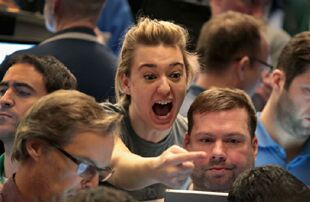美国股市强劲反弹 巨幅波动重现市场
|
US stocks staged a late rebound on Tuesday that halted a three-day global rout but underlined how volatility has returned to markets after years of unusual calm. The Dow Jones Industrial Average ended up 567 points, or 2.3 per cent, at 24,913, a day after having recorded its biggest one-day points drop ever. The S&P 500 was up 1.7 per cent to 2,695, its best day since Donald Trump was elected US president. The technology-heavy Nasdaq Composite gained 2.1 per cent. The sharp late-day reversal on Tuesday pulled all three major indices back into positive territory for the year.
Global stock market turbulence left European and Asian bourses deeply in the red yesterday as investors struggled to cope with the return of market volatility after years of unusual calm. Stocks in Asia and Europe lost as much as 5 per cent as they caught up with Wall Street’s biggest loss in six years the previous day. US stocks took a rollercoaster ride, falling up to 2.1 per cent in the first minutes of trade before erasing losses by mid-day. The focus for many investors was on the Vix volatility index, Wall Street’s so-called fear gauge, which briefly shot to its highest level since the 2015 Chinese currency devaluation. Funds that allow investors to bet on tranquil markets were at the centre of this week’s fall in equities, plummeting in value. Credit Suisse and Nomura both pulled volatility-based securities from the market. Shares of Cboe Global Markets, which owns the Vix index, tumbled as much as 17 per cent as investors feared the closures could hit trading volumes. “When [shorting volatility] doesn’t work, it really unwinds quickly and you get catastrophic losses,” said Sebastien Page, at T Rowe Price. “Why are investors attracted to it? Because in normal times it consistently makes money until it doesn’t and then you lose big.” Market ructions have sliced 8 per cent off the S&P 500 since stocks hit January’s record. At one point, the Dow Jones Industrial Average briefly suffered a technical correction of 10 per cent. The tumble in Europe and Asia saw benchmark stock indices in Japan and Hong Kong slide more than 4 per cent and 5 per cent respectively. German, Spanish, British and French benchmarks dropped more than 2 per cent. The whipsaw trading in US stocks came a day after the market suffered its biggest percentage fall since August 2011. The losses were triggered by investor concerns that an era of cheap money was drawing to a close in the face of renewed inflationary pressures. Faster wage and economic growth has emerged across the developed world. Investors are readying for the possibility that the Federal Reserve and European Central Bank could tighten policy more aggressively than thought at the end of last year. “We had a very prolonged period of easy monetary policy and if you think about it like a patient, central banks viewed the economy as being on life support,” said Brian Levitt, a senior investment strategist with Oppenheimer Funds. “Given where we are now in the economic cycle, with growth generally strong, the global economy does not need to be on life support.” The Vix index remained above its historic average, trading at 37 late in the US session. The FTSE 100 slid 2.6 per cent while the Euro Stoxx 600 declined 2.4 per cent. Japan’s Nikkei 225 dropped 4.7 per cent while Hong Kong’s Hang Seng tumbled 5.1 per cent. Equity volatility spread to the $14tn US Treasury market, often a haven in market routs. The yield on the two- and 10-year notes both rose 7 basis points, to 2.09 and 2.77 per cent respectively. Torsten Slok, chief international economist at Deutsche Bank, said: “Markets are coming to the conclusion that the US economy is close to overheating and therefore that the risks of inflation are bigger than the risks of a recession.” |









